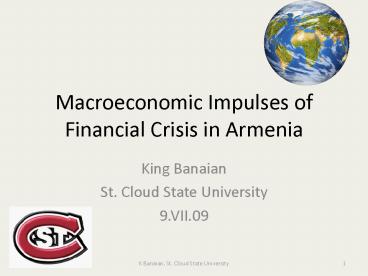Macroeconomic Impulses of Financial Crisis in Armenia
1 / 25
Title:
Macroeconomic Impulses of Financial Crisis in Armenia
Description:
K Banaian, St. Cloud State University. Macroeconomic Impact of the Financial Crisis on Armenia ... K Banaian, St. Cloud State University. 5. Almost all loan ... –
Number of Views:86
Avg rating:3.0/5.0
Title: Macroeconomic Impulses of Financial Crisis in Armenia
1
Macroeconomic Impulses of Financial Crisis in
Armenia
- King Banaian
- St. Cloud State University
- 9.VII.09
2
Macroeconomic Impact of the Financial Crisis on
Armenia
- Some first principles
- Financial activities in Armenia
- Remittances as a form of contagion or
interdependence? - The economic effects of remittance drops
- Concluding thoughts
3
Your first econ class had this
Govt
Rest of World
4
Dividing the balance of payments
5
Financial sector
- Source of concern over underdevelopment.
- Focus initially on financing SME sector
- Major advances in household services
6
Almost all loan increases in drams for households
- How much for mortgages and building? How much
for consumer/auto loans? - Interest rates in dram and forex nearly equal.
No sign of expected depreciation of dram.
7
The dedollarization story, in one picture
- Mental model The dram is good, and we have
promise that it holds value against dollar and
euro and ruble. Keep the promise, and we will
move the savings there. Inflation targeting
helps keep the promise.
8
Banks increasingly lending long(intermediation
begins)
9
But the music ends
- Fear of loss broken mental model
- People reverse the flow, hold fewer drams
- Banks seeing outflow, concern for valuations,
decide to hold more reserves - Like US, credit crisis the result of bank caution
- Regulatory?
- Combination ends boom in lending
10
Consolidated bank balance sheet
11
Drop in drams relative to deposits pronounced
- Also note rise in reserves held by banks
12
Shock? What shock?
- What shock hit the economy then?
- Those responses should be rather fast, so timing
appears to be October-November - No spike in interest rates
- Trade deficit widening perhaps a sign?
13
Tale of two reports
- 31 October 2008
- Rising inflation, high credit growth, and a
widening current account deficit have raised
concerns about overheating.
- 3 March 2009
- Since November 17, 2008, Armenia has been
confronted by a set of external shocks and now
faces fading confidence in the currency and
financial system.
14
That same graph, extended 9 months
15
Two risks
- Intermediation
- Exchange rate
- Both mean bank risk higher. High capital and
liquidity means on average banks will be fine. - But not all banks are average.
16
What caused this?
- Construction sector nice presentation yesterday
on end of rise in apartment rents - Remittances all talk about, nobody shows
- Trade could mining have done this?
- I will only speculate on this does not seem big
enough - Export decline in 2008 just 7.2
- Imports rose much more
17
Remittance flows slowed in 2008IV
- Russia announces in January that it halves the
number of work permits for CIS emigrants in 2009
(Stratfor, 3 Feb 2009) - Expectations of lower income would have changed
household behavior
18
Consumer confidence was already slipping
19
So thats three BOP hits
- Foreign output shock reduces export of goods
- Shock reduces export of labor, and return flow of
remittances - Imports will fall, but not by as much.
- Small open economy this is element of increased
interdependence of Armenia
20
How big a shock?
- Two models to use
- Appendix in Banaian and Roberts suggests
remittances alone would account for 3.5 decline
in GDP - Does not include FDI decline
- Mrktchyan, Dabla-Norris and Stepanyan dont
provide a hard number but model predictions are
borne up by the data - Shock to consumption is unambiguously negative,
quicker than a remittance shock. - Again, shock is result of exposure to world
economy
21
And thats not a bad thing!
- Article in new The Atlantic on Moldova What
crisis? - Per capita income about half Armenia
- Complain about corruption and politics but not
finance. - Cash-only economy, but 5th on The Banker World
Financial Health Index - Is that good?
- Danger of isolationism
22
Not contagion but interdependence
- Proper diagnosis is important
- Question is how to make Armenia more stable as it
opens to the world economy - Market mechanisms
- Diversify
23
Market mechanisms
- Banks need natural growth
- Perhaps too quick push into lending
- Dont addict banks to guarantees
- We Americans have some experience with forcing a
secondary mortgage market. It will cost us 384
billion through 2010. Dont imitate us. - Exchange rate now generates a price useful as a
guide to market evaluation of policy
24
Diversify
- By globalizing, Armenia exposes itself to new
technologies, new goods, better prices - Labor has opportunity to work for higher return.
- But trade in goods and labor has geographic
tendencies. - You cant pick your neighbors.
- But you can try to diversify
25
Closing thought
- Contagion sounds like a disease to control
- Current crisis is not the result of contagion
- Natural response to external shocks
- Armenias crisis is unique, needs its own
medium-term solution - More stable production AND more stable trade, in
goods AND labor, would be my prescription































